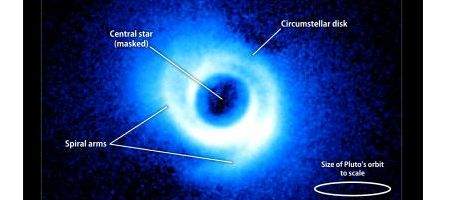Astronomers have for the first time spotted a disk of gas and dust around a sun-like star that shows spiral-arm-like structures.

They say the features may indicate the presence of embedded but as-yet-unseen planets.
“Detailed computer simulations have shown us that the gravitational pull of a planet inside a circumstellar disk can perturb gas and dust, creating spiral arms,” says Carol Grady, an astronomer with Eureka Scientific, who’s based at NASA’s Goddard Space Flight Center.
“Now, for the first time, we’re seeing these dynamical features,”
The disk was discovered as part of the Strategic Exploration of Exoplanets and Disks with Subaru (SEEDS), a five-year-long near-infrared study of young stars and their surrounding dust disks using the Subaru Telescope at Mauna Kea in Hawaii.
“What we’re finding is that once these systems reach ages of a few million years, their disks begin to show a wealth of structure – rings, divots, gaps and now spiral features,” says John Wisniewski of the University of Washington. “Many of these structures could be caused by planets within the disks.”
The disk surrounds SAO 206462, an 8.7-magnitude star located about 456 light-years away in the constellation Lupus. Astronomers estimate that the system’s only about nine million years old. The gas-rich disk spans some 14 billion miles, more than twice the size of Pluto’s orbit.
The near-infrared image reveals a pair of spiral features curving along the outer disk. Theoretical models show that a single embedded planet can produce a spiral arm on each side of a disk, but the structures around SAO 206462 don’t form a matched pair, suggesting there are probably two unseen planets, one for each arm.






